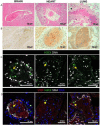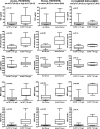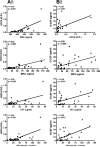NETosis promotes cancer-associated arterial microthrombosis presenting as ischemic stroke with troponin elevation
- PMID: 26916297
- PMCID: PMC4769435
- DOI: 10.1016/j.thromres.2016.01.009
NETosis promotes cancer-associated arterial microthrombosis presenting as ischemic stroke with troponin elevation
Abstract
Introduction: Large elevations of high sensitive Troponin T (hsTnT) in ischemic stroke patients is associated with a poor outcome. In a pilot study we found a high prevalence of malignancies among these patients. Since neutrophil extracellular traps (NETs) have been linked to cancer-associated thrombosis, we hypothesized that the concomitant cerebral and myocardial ischemia could be the result of a NET-induced hypercoagulable state.
Materials and methods: Clinical assessments, plasma analyses and autopsies with histopathology (in cases of in-hospital mortality) were performed on ischemic stroke patients with high elevations of hsTnT (N=12) and normal hsTnT (N=19).
Results: Patients with hsTnT elevation had an unexpectedly higher prevalence of cancer (p=0.002), half of which were diagnosed post-mortem. Autopsies of these patients revealed widespread myocardial, cerebral and pulmonary microthrombosis with H3Cit in thrombi. A pro-coagulant state and an increase of the NET specific marker citrullinated histone H3 (H3Cit) was found in plasma of patients with elevated hsTnT compared to patients with normal levels (p<0.001). Plasma analyses in cancer patients showed even higher H3Cit levels (p<0.001), and an increase in granulocyte colony-stimulating factor, known to prime neutrophils towards NETosis. H3Cit correlated positively with thrombin-antithrombin complex (p=0.004) and soluble P-selectin (p<0.001), further linking NETosis to the pro-thrombotic state.
Conclusions: The high prevalence of known or occult cancer in our study suggests that cancer-associated arterial microthrombosis may be underestimated. By linking the thrombosis to NETs, we suggest markers of NETosis that could aid in revealing cancer in arterial microthrombosis as well as arterial microthrombosis in cancer.
Keywords: Cancer-associated microvascular thrombosis; Ischemic stroke; Neutrophil extracellular traps; Troponin elevation.
Published by Elsevier Ltd.
Figures



References
-
- Kerr G, Ray G, Wu O, Stott DJ, Langhorne P. Elevated Troponin after Stroke: A systematic review. Cerebrovasc Dis. 2009;28(3):220–6. - PubMed
-
- Fure B, Bruun Wyller T, Thommessen B. Electrocardiographic and troponin T changes in acute ischemic stroke. J Intern Med. 2006;259(6):592–7. - PubMed
-
- Barber M, Morton JJ, MacFarlane PW, Barlow N, Roditi G, Stott DJ. Elevated troponin levels are associated with sympathoadrenal activation in acute ischaemic stroke. Cerebrovasc Dis. 2007;23(4):260–6. - PubMed
-
- Mahajan VS, Jarolim P. How to interpret elevated cardiac troponin levels. Circulation. 2011 Nov 22;124(21):2350–4. - PubMed
-
- Scheitz J, Nolte C, Laufs U, Endres M. Application and Interpretation of High-Sensitivity Cardiac Troponin Assays in Patients With Acute Ischemic Stroke. Stroke. 2015;46:1132–40. - PubMed
Publication types
MeSH terms
Substances
Grants and funding
LinkOut - more resources
Full Text Sources
Other Literature Sources
Medical

